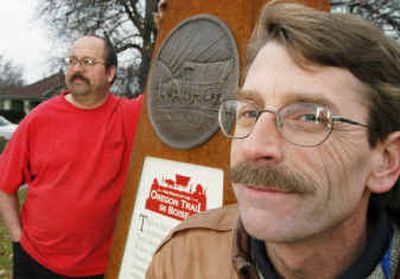Boise volunteers mark pioneers’ path

BOISE – Two Boise residents’ passion for neighborhood history landed new Oregon Trail obelisks in the North End, marking the tail end of a decadelong project.
Mark Baltes, a public artist, and Glen Corbeil, a union electrician, worked to place many of the 17 steel Oregon Trail obelisks along Boise Avenue and in the city’s North End.
“It takes a couple of muscles and a whole lot of will power,” Corbeil said. “It’s more of a mental thing.”
The Oregon Trail monument project originated out of the Boise Village Neighborhood Association about 10 years ago. The community transformed Boise Avenue into parks commemorating points along the Oregon Trail, a road pioneers traveled to cross the Old West.
In the North End, the two new monuments near Harrison Boulevard mark an emigrant passageway widely used after 1862, according to historian Barbara Perry Bauer’s research for the project.
These two monuments arrived in the North End a day before Halloween. Until recently, passers-by could only see such monuments – 7-foot-tall, rust-colored semi-pyramids – along Boise Avenue in southeast Boise.
Baltes and Corbeil hauled and bolted down the new structures on a path that branched off the Oregon Trail. One obelisk stands on the busy intersection of 15th Street and Hill Road, and the other is on Harrison Boulevard and Resseguie Street. Each monument features historic information, a bronze relief medallion of a covered wagon, maps, and a user-friendly bicycle tour of Boise’s pioneer sites.
Two years ago, the North End Neighborhood Association received a $9,000 grant from the Mayor’s Neighborhood Reinvestment Program to place the new monuments, but the story goes further back.
“We’re two neighborhood volunteers who worked hand-in-hand,” Baltes said, but “this is Glen Corbeil’s brainchild. Anything that any of us do comes from the fact that it was his good idea.”
About 10 years ago, Corbeil joined a team of volunteers who wanted to beautify Boise Avenue. Because the street diagonally crosses the city’s north-south grid, there were a lot of small, underused triangles of space. Corbeil threw himself into a landscaping project aimed at making those areas into Oregon Trail historic sites. He ended up leading the Oregon Trail project and writing neighborhood and federal grant applications with his wife, Mary Anne, for the endeavor.
Corbeil planned to set 32 obelisks, but he got just enough money for the 15 on Boise Avenue. He estimates all the currently placed monuments, including the two in the North End, took about $40,000 to build.
He grew tired of tipping and placing some of the 400-pound monuments alone and with his wife. So Baltes, who kiln-fired the porcelain, fade-resistant placards that displayed art and information on all of the monuments, helped with manpower.
“I’m a history buff,” Baltes said. “I just naturally gravitate toward the history of my hometown.”
Baltes, who is a former historical preservation chairman of the North End Neighborhood Association, found two spots for the monuments that already belonged to Boise Parks and Recreation and received government approval to place them.
The corner on 15th and Hill Road stood out to the two because the area was open space with no amenities, Baltes and Corbeil said.
“The monument really anchors the site. It becomes a park where there was just a vacant lot,” Corbeil said.
Corbeil said he’s done with the project after the remaining monument art comes in.
“After 10 years, I would rather walk the trail,” Corbeil said. “That took five months.”